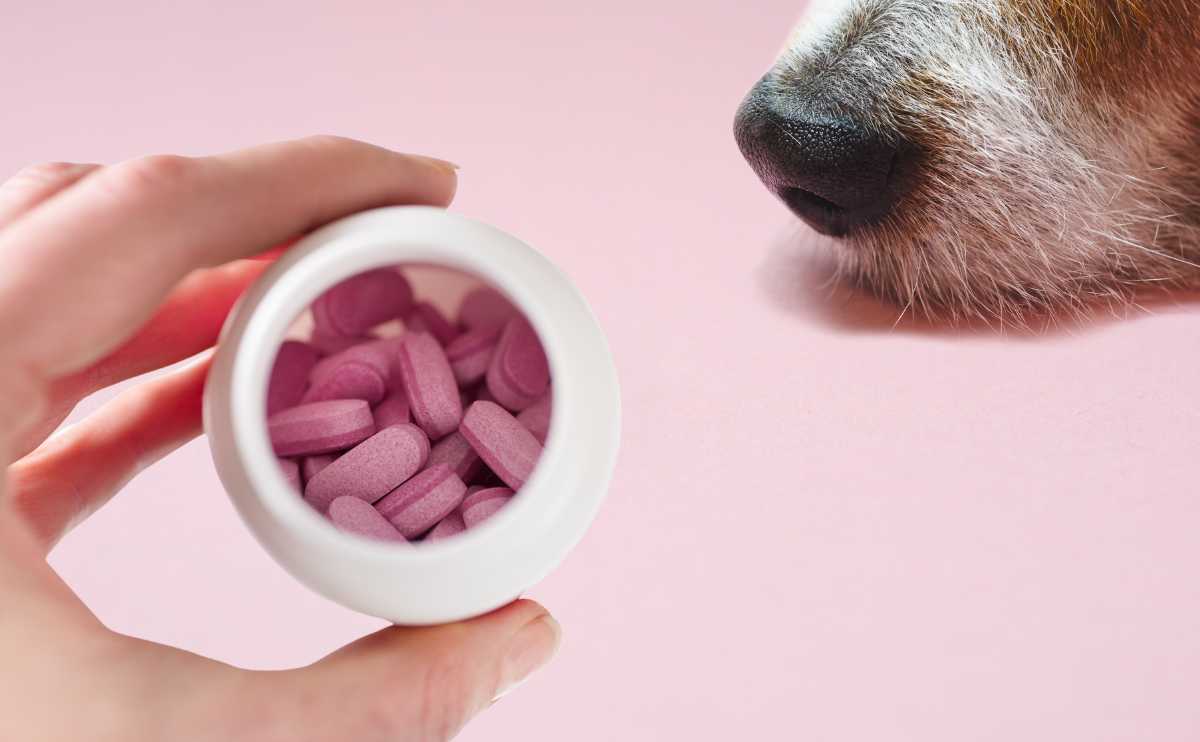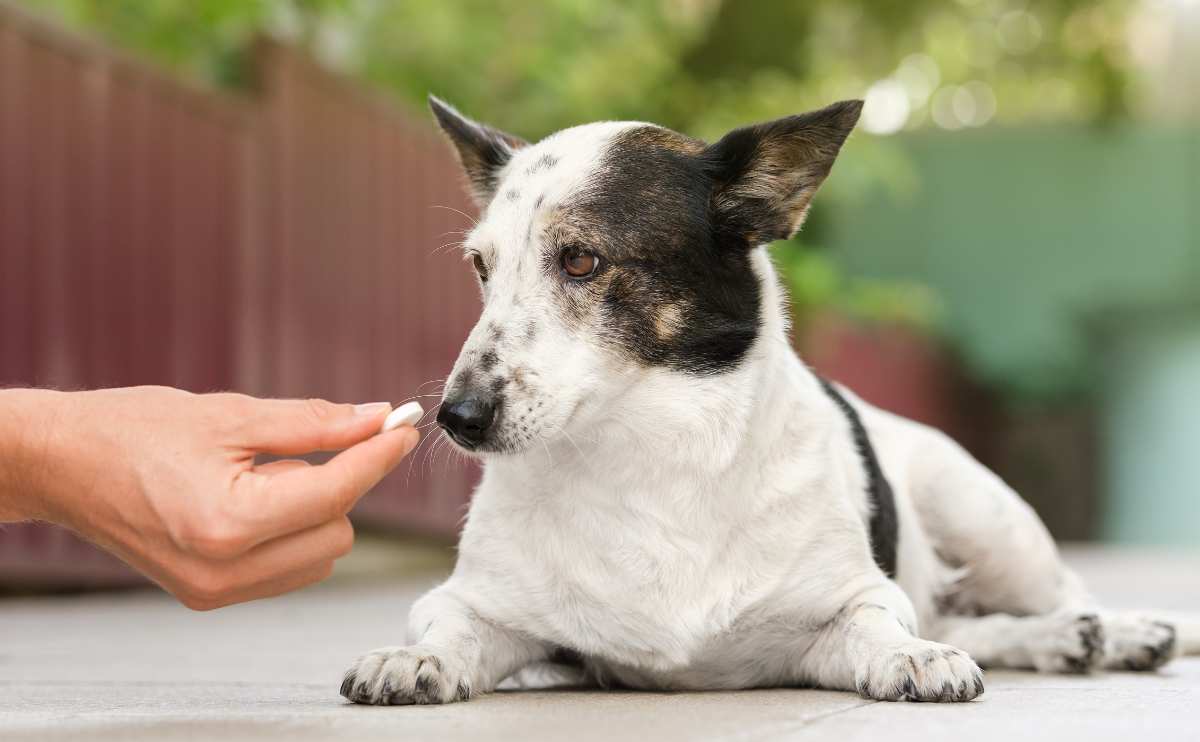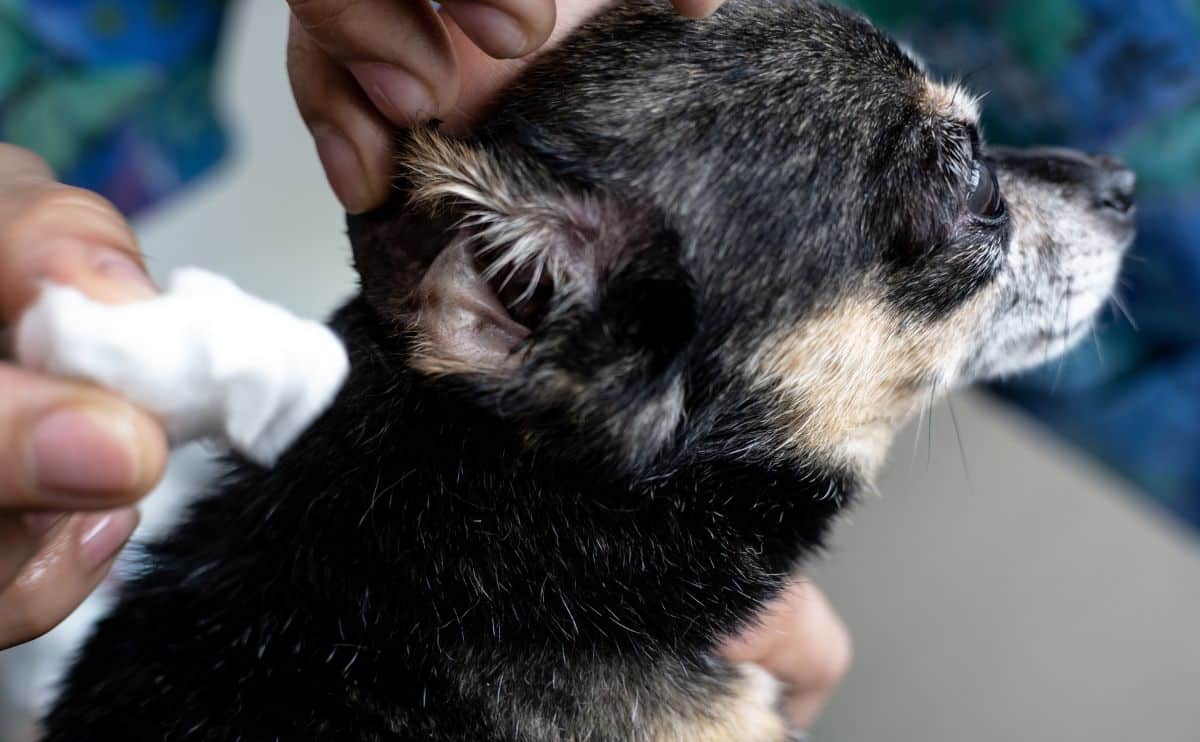When you purchase through links on our site, we may earn a commission. Here’s how it works.

Benadryl (diphenhydramine HCI) is one of the very few human over-the-counter medications that are generally considered safe for dogs and that veterinarians often recommend. Many pup owners find this antihistamine helpful in relieving mild allergic reactions, mild itchy skin, and motion sickness in their canine counterparts. The widely accepted guideline is 1mg per pound of your dog’s weight.
But before you share the Benadryl in your medicine cabinet with your dog, it’s important to know a few details to ensure your pup’s safety. We’ll tell you which forms of Benadryl are safe to administer to your pup, give you a handy dosage chart, and answer some other questions you may have about giving this OTC medication to your furry friend.
- How Much Benadryl Can I Give My Dog?
- Benadryl For Dogs: Dosage By Weight
- Children's Liquid Benadryl For Dogs Dosage Chart
- Types Of Benadryl To Avoid Giving Your Dog
- Use Benadryl Cautiously With Some Dogs
- Our Personal Experience With Benadryl And Dogs
- Frequently Asked Questions
- Alternatives To Benadryl In Treating Chronic Allergy Symptoms
How Much Benadryl Can I Give My Dog?
While Benadryl is safe for most dogs, please remember that it’s so important to discuss giving it or any medication or supplement with your veterinarian. Your vet can make sure any non-prescribed product, like Benadryl, is safe for your dog’s specific health conditions and will help give you dosing guidance.
With that said, the general dosing guide for Benadryl is pretty straightforward. Most vets and experts recommended a standard dose of roughly 1mg/pound. The standard Benadryl you’ll find in stores is 25mg/tablet for adult Benadryl. You can also use Children’s Liquid Benadryl, which is 12.5mg/5 ml. However, vets usually only recommend Children’s Liquid Benadryl for dogs under 10 pounds because it’s easier to achieve an accurate dose vs. tablets.
You can increase this dose a bit if needed, but be sure to get your vet’s okay. Benadryl is safe to give to dogs every eight to 12 hours (one to three times per day) in the short term. But for long-term use, it’s a good idea to consult your vet.
Benadryl For Dogs: Dosage By Weight
| Dog’s Weight | Benadryl Dosage |
|---|---|
| 5 lbs | 5 mg – 2 ml Children’s Benadryl |
| 10 lbs | 10 mg – 4 ml Children’s Benadryl |
| 20 lbs | 20 mg – 3/4 tablet |
| 30 lbs | 30mg- 1 tablet |
| 40 lbs | 40mg- 1.5 tablets |
| 50 lbs | 50mg- 2 tablets |
| 60 lbs | 60mg- 2.5 tablets |
| 70 lbs | 70mg- 2.5 tablets |
| 80 lbs | 80mg- 3 tablets |
| 90 lbs | 90-100mg- 3.5-4 tablets |
Did You Know?
Children’s Liquid Benadryl For Dogs Dosage Chart
In general, vets usually recommend tablets for dogs over 10 pounds. However, if your dog loathes taking pills or you have trouble cutting up tablets, Children’s Liquid Benadryl is also safe for dogs of all sizes.
| Dog’s Weight | Children’s Liquid Benadryl Dosage |
|---|---|
| 5 lbs | 2 ml |
| 10 lbs | 4 ml |
| 20 lbs | 8 ml |
| 30 lbs | 12 ml |
| 40 lbs | 16 ml |
| 50 lbs | 20 ml |
| 60 lbs | 24 ml |
| 70 lbs | 28 ml |
| 80 lbs | 32 ml |
| 90 lbs | 36 ml |
| 100 lbs | 40 ml |
Types Of Benadryl To Avoid Giving Your Dog
Diphenhydramine hydrochloride is the active ingredient in “American Benadryl” (found in the U.S., Canada, Singapore, Taiwan, Italy, and Hong Kong). However, in the U.K. and Denmark, the active ingredients are acrivastine in Benadryl Allergy Relief and cetirizine in Benadryl Once a Day. Limited information exists on acrivastine and cetirizine use in dogs, so if you’re in Europe, make sure the active ingredient is diphenhydramine, the only form of Benadryl that’s considered safe for dogs.
Regarding “American Benadryl,” you should avoid giving your pup the following forms:
- Liqui-Gels: Capsules are nearly impossible to break up to get the appropriate dose. They’re also absorbed differently in dogs than in humans so this may cause issues with your pup’s dosage.
- Adult Liquid Benadryl: contains alcohol, which is toxic to dogs.
- Benadryl Allergy Plus Congestion: This Benadryl formula contains phenylephrine HCl, a common decongestant in human cold medications that’s not safe for dogs.
- Extra Strength: While extra strength Benadryl is safe for dogs, it comes in 50 mg/tablet, and most vet dosing guidelines are for the 25 mg/tablet standard Benadryl. So, you’ll have to do your own calculations. To ensure your pup’s safety, it’s best to stick with vet guidelines.
Use Benadryl Cautiously With Some Dogs
Benadryl can make some conditions worse, so you should use caution if your pup suffers from any of the following health issues. Be sure to discuss Benadryl use with your veterinarian in these cases and if there’s a possibility of adverse interactions with any other medication your furry friend is taking.
- Pregnancy or nursing
- Glaucoma
- Dry eye
- Heart disease
- High blood pressure
- Chronic obstructive pulmonary disease (COPD)
Our Personal Experience With Benadryl And Dogs
Several members of our team occasionally give our pups Benadryl under our veterinarians’ recommendations. We’ve all found it to be safe and effective.

Lily got a hornet sting on her left back leg while on a walk. It swelled up quickly. When we got home, we immediately gave her Benadryl and monitored her symptoms closely for any changes. Additionally, we applied ice for 10 minutes once an hour. While she was still limping a few hours later, this treatment combo helped reduce some of the swelling and discomfort. Thankfully, within two days, Lily was feeling significantly better.
– Michelle Schenker, co-founder of Canine Journal and pet parent of two rescue dogs
Frequently Asked Questions
How Often Can I Give My Dog Benadryl?
Typically, the effects of Benadryl last in your furry friend’s system for six to eight hours. But most vets and experts recommend giving your pup Benadryl every eight to 12 hours to account for differences in metabolism.
How Long Does It Take For Benadryl To Kick In For Dogs?
In most cases, it only takes about 1/2 hour to one hour for Benadryl to become effective for dogs. However, this time frame may vary depending on the dose you gave your pup as well as her age, weight, and health status.
Are There Side Effects & Overdosing Concerns With Benadryl Use In Dogs?
Most dogs tolerate Benadryl extremely well, and the risk of overdose is low. Side effects and overdosing are rare, but see our ultimate guide on Benadryl use in dogs to learn more about both of these concerns, as well as more detailed information about how Benadryl can help your pup.
Is Benadryl Effective For Dog Anxiety?
The sedative effects of Benadryl may help some dogs with situational anxiety, such as for fireworks, thunderstorms, or car rides. However, Benadryl can cause hyperactivity rather than sedation in some dogs. So many experts believe you have better options for anxiety relief for your furry friend. Alternatives to Benadryl include CBD oil, dog-specific calming supplements, or prescription medications for chronic anxiety.
Can I Use Children’s Chewable Tablets For My Dog?
Yes, Children’s Chewable Benadryl tablets are safe for dogs. They’re ideal for smaller dogs. A full chewable children’s tablet contains 12.5 mg of diphenhydramine, so you can cut one in half for dogs weighing less than 10 pounds as an easy alternative to Children’s Liquid Benadryl.
Alternatives To Benadryl In Treating Chronic Allergy Symptoms
One of the most popular uses of Benadryl in dogs is to treat allergic reactions. This application can be extremely effective for temporary or short-term allergy symptoms, such as reactions to an insect bite or bee sting or mild seasonal allergies from pollen. However, Benadryl isn’t your best line of defense if your pup suffers from long-term allergy problems.
If you’ve noticed that your pup is incessantly scratching her skin no matter what time of year, she could have a food intolerance or allergies to household environmental factors, such as dust mites or mold. For chronic allergic symptoms, which can include itchy, irritated skin and/or digestive issues, you may want to consider dog allergy supplements, daily medications, or monthly injections.
However, for chronic allergy symptoms, we recommend first consulting your veterinarian. Alternatively, you can give your pup an at-home dog allergy test kit. These kits test for intolerances to many food and environmental factors. Then, you can share these results with your vet to work on further diagnostics and a treatment plan.
Tagged With: Allergies, Medication

